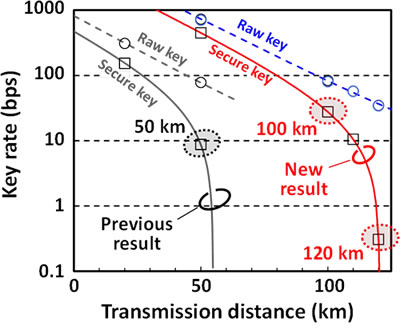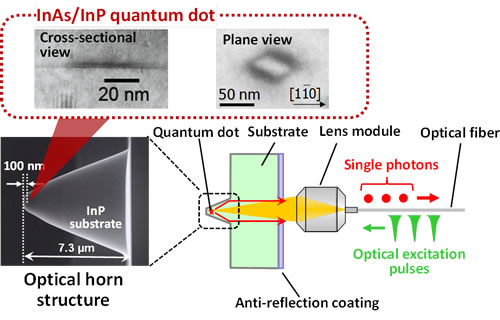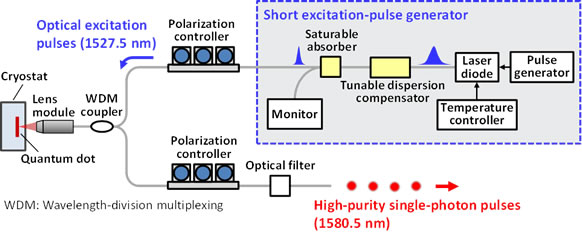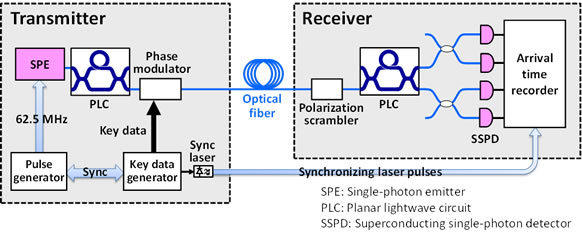Archived content
NOTE: this is an archived page and the content is likely to be out of date.
University of Tokyo, Fujitsu, and NEC Succeed in Quantum Key Distribution from Single-Photon Emitter at World-Record Distance of 120 km
Driving toward the practical implementation of the ultimate in secure communications for metropolitan areas
Institute for Nano Quantum Information Electronics, the University of Tokyo,Fujitsu Laboratories Ltd.,NEC Corporation
-
[1] Quantum key distribution
Secret communications where a sender and receiver can safely share a private key by taking advantage of quantum mechanics. Quantum mechanics can make it possible to detect the act of eavesdropping, allowing for a secure key distribution that is proven by physical principles.
-
[2] Single-photon emitter
A non-classical light source capable of emitting a light pulse containing just a single photon at the desired timing. This can be achieved by quantum dots, atoms, or ions having discrete energy levels.
-
[3] Quantum dot
A nanometer-sized semiconductor crystal that can confine an electron in three dimensions. When an electron is confined in this nanocrystal, the electron density of states is completely discrete. This has previously been applied to lasers, optical amplifiers, and single-photon emitters. In 1982, Professors Yasuhiko Arakawa and Hiroyuki Sakaki put forward the general concept of quantum dots.
-
[4] Superconducting single-photon detector
An optical detector that uses the phenomenon of the destruction of electrical superconductivity by light absorption. They are far superior in performance to single-photon detectors using existing semiconductors, having sufficient sensitivity for single photons, and low noise (dark count rate), high quantum efficiency, and high temporal resolution. Rapid technological progress has been reported in recent years.
-
[5] Optical horn structure
A parabolic-shaped semiconductor microscopic structure. Typically, because there is a large difference in the refractive index at the interface between a semiconductor's matrix material and vacuum, most photons generated from the quantum dots are totally reflected, and the percentage of photons that can be emitted is less than 1%. By instead using this interface's total reflection with an optical horn structure, single photons are able to be emitted in one direction from quantum dots with much higher efficiency.
-
[6] Tokyo QKD Network
A field trial optical network, which the National Institute of Information and Communications (NICT) brought into operation in October 2010 for the purpose of bringing QKD in to practical application. QKD systems developed by NEC and other companies are installed in four hubs located in Tokyo's Otemachi Koganei, Hakusan, and Hongo, and reliability and performance evaluations are performed at transmission distances ranging from 10 km to 90 km.
About Fujitsu
Fujitsu is the leading Japanese information and communication technology (ICT) company, offering a full range of technology products, solutions, and services. Approximately 159,000 Fujitsu people support customers in more than 100 countries. We use our experience and the power of ICT to shape the future of society with our customers. Fujitsu Limited (TSE: 6702) reported consolidated revenues of 4.8 trillion yen (US$40 billion) for the fiscal year ended March 31, 2015. For more information, please see http://www.fujitsu.com.
About The University of Tokyo
The University of Tokyo was established in 1877 as the first national university in Japan. As a leading research university, the University of Tokyo offers courses in essentially all academic disciplines at both undergraduate and graduate levels and conducts research across the full spectrum of academic activity. The university aims to provide its students with a rich and varied academic environment that ensures opportunities for both intellectual development and the acquisition of professional knowledge and skills.
The University of Tokyo is known for the excellence of its faculty and students and ever since its foundation many of its graduates have gone on to become leaders in government, business, and the academic world. For more information, please see: http://www.u-tokyo.ac.jp/index_e.html.
About Fujitsu Laboratories
Founded in 1968 as a wholly owned subsidiary of Fujitsu Limited, Fujitsu Laboratories Ltd. is one of the premier research centers in the world. With a global network of laboratories in Japan, China, the United States and Europe, the organization conducts a wide range of basic and applied research in the areas of Next-generation Services, Computer Servers, Networks, Electronic Devices and Advanced Materials. For more information, please see: http://www.fujitsu.com/jp/group/labs/en/.
About NEC Corporation
NEC Corporation is a leader in the integration of IT and network technologies that benefit businesses and people around the world. By providing a combination of products and solutions that cross utilize the company's experience and global resources, NEC's advanced technologies meet the complex and ever-changing needs of its customers. NEC brings more than 100 years of expertise in technological innovation to empower people, businesses and society. For more information, visit NEC at http://www.nec.com.
Based on its Mid-term Management Plan 2015, the NEC Group globally provides "Solutions for Society" that promote the safety, security, efficiency and equality of society. Under the company's corporate message of "Orchestrating a brighter world," NEC aims to help solve a wide range of challenging issues and to create new social value for the changing world of tomorrow. For more information, please visit http://www.nec.com/en/global/about/solutionsforsociety/message.html.
Press Contacts
Dr. Yasuhiko Arakawa
Institute for Nano Quantum Information Electronics
![]() Phone: +81-3-5452-6245
Phone: +81-3-5452-6245
![]() E-mail: arakawa@iis.u-tokyo.ac.jp
E-mail: arakawa@iis.u-tokyo.ac.jp
Company:The University of Tokyo
Technical Contacts
Dr. Yasuhiko Arakawa
Institute for Nano Quantum Information Electronics
![]() Phone: +81-3-5452-6245
Phone: +81-3-5452-6245
![]() E-mail: arakawa@iis.u-tokyo.ac.jp
E-mail: arakawa@iis.u-tokyo.ac.jp
Company:The University of Tokyo
All company or product names mentioned herein are trademarks or registered trademarks of their respective owners. Information provided in this press release is accurate at time of publication and is subject to change without advance notice.
Date: 28 September, 2015
City: Tokyo and Kawasaki
Company:
Institute for Nano Quantum Information Electronics, the University of Tokyo / Fujitsu Laboratories Ltd. / NEC Corporation



